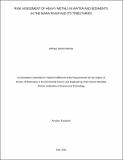| dc.description.abstract | The present study assessed the levels of As, Cd, Cr, Hg, and Pb in water and sediments from the
Mara River and its tributaries in Tanzania. The Mara River has recently been exposed to
anthropogenic activities including, mining, industrial, and farming activities, which are potential
sources of heavy metals pollution. These emerging anthropogenic activities with a destructive
impact on the environment motivated the author to conduct a risk assessment of heavy metals in
the Mara River and its tributaries. In this endeavor, the author used indices, principal component
analysis (PCA), and sediment quality guidelines (SQGs) tools to study the heavy metals pollution
status in the area comprehensively. The study was conducted in the dry and rainy months of May
and October 2019, respectively. Geochemical indices used in the present study were geo accumulation index (Igeo), enrichment factor (EF), contamination factor (CF), modified
contamination degree (mCd), pollution load index (PLI), potential ecological risk factor (Er
i
), and
potential ecological risk index (RI). Moreover, the sediment quality guidelines (SQGs) were used
for result comparisons. The principal component analysis (PCA) results indicated dominant
loadings for As and Pb in sediments during the rainy month. Comparing sediment concentrations
with sediment quality guidelines (SQGs) revealed that As and Cd may harm sediments-dwelling
aquatic organisms. Correlation coefficient results indicated that As had a strong negative
correlation with the other elements in sediments during the dry month. The analysis of
environmental risk indices revealed significant enrichment of sediments with As and Cd.
Contamination of As, Cd, and Pb along the Mara River was extremely severely enriched and
linked to anthropogenic sources. Moreover, Cd and As in tributaries were elevated in the rainy
month than in the dry months of 2019. As a result, enrichment factors of As, Cd, and Pb were
extremely severely enriched. However, low contamination degree and very low pollution existed
in water and sediments in the study area. Depending on rain and drought conditions, differentiated
efforts are needed to minimize the effects of elemental loadings in the Mara basin ecosystem—
with special attention for mitigation to be paid for As and Cd. | en_US |

